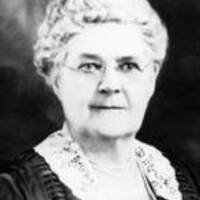Dr. Harriet B. Jones
Item
-
Title
-
Dr. Harriet B. Jones
-
Description
-
Harriet B. Jones was born in Ebensburg, Pennsylvania, and grew up in Terra Alta, Preston County, West Virginia from the age of seven. She attended Wheeling Female College in Wheeling, West Virginia, with a focus on music and art, graduating in 1875. Soon thereafter she concluded four years of Chautauqua courses. Despite completing the traditional training for middle class women of her day, Jones was discontent. She recognized the need for female physicians and pursued a medical degree at the Women's Medical College of Baltimore. She graduated in 1884 and later finished post-graduate studies to specialize in gynecology and abdominal surgery.
In 1886, she opened a medical office in Wheeling making her the first licensed female physician in West Virginia. She left private practice to be the assistant superintendent of the West Virginia State Hospital for the Insane in Weston in 1888. She returned to Wheeling three and a half years later to found a hospital for women that operated for the next twenty years. Dr. Jones regularly traveled the state and gave talks on health and hygiene issues. She successfully lobbied for state sanitariums for tuberculosis victims, a state children's home, and a girl's reformatory. She served as secretary of the West Virginia Anti-Tuberculosis League and was active in the Women's Christian Temperance Union and the West Virginia Federation of Women's Clubs. Jones also advocated for the admission of women to West Virginia University and other state colleges.
Despite her attention to many causes, Dr. Jones fiercely advocated for woman suffrage. For more than 30 years she was an enthusiastic supporter of the West Virginia suffrage movement and held numerous positions within the West Virginia Equal Suffrage Association (WVESA), serving as President in 1906. In 1907, along with National Association president Dr. Anna Howard Shaw, she addressed West Virginia lawmakers during a legislative hearing on resolutions for a suffrage amendment. The resolutions, however, did not pass in either house.
The West Virginia Legislature of 1915 brought the question of full suffrage to the voters in the 1916 election. In preparation, the activities of the WVESA accelerated. For her part, Dr. Jones arranged a speaking tour around the state for Mary E. Craigie, chairman of church work for the National Woman Suffrage Association, and two suffragists from Ohio. She also organized a questionnaire and sent it to 150 newspaper editors, receiving 53 positive responses for suffrage. Leading up to the vote, she spoke frequently for the campaign in West Virginia. Still, the 1916 amendment failed by a wide margin.
After ratification of the federal suffrage amendment in West Virginia in 1920, Dr. Jones continued her life of public service becoming active in the League of Women Voters. In 1924, she was first elected to West Virginia House of Delegates as a Republican representing Marshall County and served two terms. She was President of the Board of Directors of the West Virginia State Industrial Home for Girls for twelve years and a member of the State Board of Examiners for Nurses for several years as well. She is credited for writing the history of the suffrage movement in West Virginia in the History of Woman Suffrage published by the National Association in 1922. She died in Glen Dale, Marshall County, West Virginia, in 1943.
 harriet_jones_medium.jpg
harriet_jones_medium.jpg